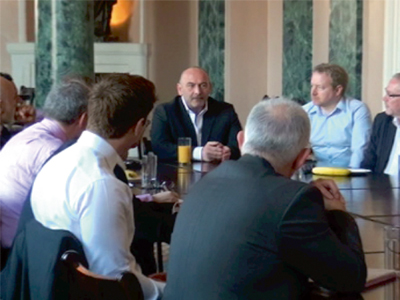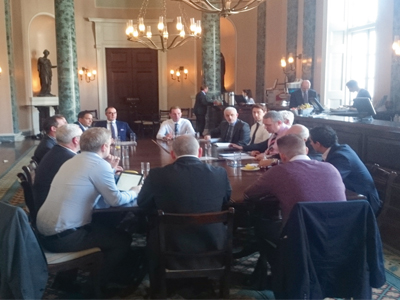The Theatre Royal, Drury Lane
The latest Strategies for Success roundtable event with Ricoh took place in London in June 2015. Discussion chair Andy Knaggs relates the morning’s musings.
Hard on the heels of the Stirling Castle roundtable event in Scotland, reported in Digital Printer July 2015, the show moved back to London for another discussion on technology adoption, this time at the Theatre Royal, Drury Lane.
Once again held in partnership with Ricoh, the discussion explored the views of participants towards technology adoption: the thought processes involved, whether productivity and efficiency were more important than new added value services, whether software was the real route to success, and what the role of technology manufacturers should be.
It began, however, with a question about timing: was the current climate – post-recession, post-General Election – a good one to invest in?
‘It is a good time to invest now,’ said John Whelan of Darwin Press. ‘Without getting too much involved in politics, we’ve now got a stable government. When you do invest you do see the benefit of click charge with Ricoh kit and find that it is stealing work from traditional litho. People are prepared to pay more for digital than for litho. We would debate whether it’s as good, but clients are more accepting of quality, even if it is very slightly not the same. People are less picky. I don’t think I’ve ever had a problem with a digital job.’
Alan Rigglesford of Clicks has recently invested in the world’s first Screen Truepress Jet W3200UV HS flatbed printer with a roll-to-roll option. Clearly, he agrees that the time is apposite for investment. He said: ‘We got rid of three machines to put one in, gaining productivity and space saving benefits. But also, giving the sales team the confidence to go into an agency knowing they have the latest equipment behind them is important as well.’
Ivor Solutions is also investing, both in digital equipment and in acquisitions to broaden its finishing capabilities. It has embarked on Lean Manufacturing procedures – as it needs to since there can be 2000 jobs going through at any given point, according to Spencer Slee. He added: ‘Tracking and sequencing them in the right way to deliver on time and derive profits from managing that type of work: that’s an investment. We have made hardware investments and communications investments, but the biggest investment we are making is in time – management and decision time focusing on projects to drive efficiency.’
There is never a bad time to invest for Brilliant Media, but Simon Tabelin pointed out that ‘we create the need before we create the investment, so there is no gamble’. His colleague Tony Kenton enlarged on the firm’s attitude, saying: ‘We are not looking at this from a production viewpoint; it is whether it achieves the objectives of the client. It doesn’t matter what the media is.’

When printers talk about new equipment it is like dentists talking about more powerful drills, he said: people just want painless tooth fixing. ‘What we are trying to offer is a different perspective. Production is important and we are buying a machine every two to three months, but it is based on the clients’ needs, and we are looking at unique ways of fulfilling that.’
There was some anticipation however of certain technologies that are quickly being developed for the print market, with Nick Murray of Wellington Press having already had his appetite wetted by inkjet technology. ‘It’s got to be sheetfed: once someone comes up with that it will be fantastic. Ricoh must be trying to come up with a sheetfed machine in Japan; a B3 sheetfed inkjet that prints as well as the one shown in Telford (at Ricoh’s Customer Experience Centre)…£250,000, then it’s done and dusted.’
Over at Passion Print, Lee Deeks revealed that they are waiting for HP’s new high speed Page Wide technology to arrive. The company produces a lot of technical drawing work. His colleague Robert Grundy said: ‘With new technology, producing 2500 A0s, it will halve the time. The volume of drawings coming in, it’s higher than two years ago; we were not getting anywhere near those volumes. Now we are running that every day.’
In small format also there are interesting possibilities, said Mr Deeks: ‘We will be looking at the Ricoh 5100 with long banner. Things like the white or clear toner are very interesting too; it will do most of our work and also give us another string to our bow.’
Soft option
The question of whether more benefits will accrue from software rather than hardware going forward drew an interesting response, which eventually evolved into a discussion on the importance of IT in general. John Whelan began the debate by saying that his company viewed software as a very important aspect of becoming more efficient. Referring to Ivor Solutions’ revelation of having 2000 jobs going through at a time, he said: ‘The workflow – we don’t print hundreds and hundreds of jobs a day, so we’ve never had to worry, but now with digital print it’s how you make it efficient, and we need to do a lot of research into that. How you do 2000 jobs at the same time in your factory…that’s amazing.’
Jeff Birch, who is heavily involved in the IT infrastructure behind Ivor Solutions, explained some technical information about the system that manages this workload. This involved the creation of a web front end that can mirror any corporate hierarchy, with a server driving e-commerce order acquisition. ‘We can scrape order information from those and merge it into the workflow internally to get batch efficiencies. That’s how we manage that volume of work. We have driven that really hard and have quite regular batching meetings,’ he said.
Tony Kenton from Brilliant Media drew a distinction between software for printers’ workflow and MIS, and that for CRM/ERP and mobile apps. He said: ‘We are thinking more about and investing really heavily in social media and how we connect to our customers. That seems to be driving production, rather than thinking about workflow. Work is smaller in volume and wanted more quickly. The time it takes to put it on a system and monitor it, it’s out of the door. We are having to short cut things with bar codes and everything goes through the MIS, but where the real value comes in is where you can put human interaction.

‘A customer might, for example, want 1000 copies and we can say, we can give you another 600 with the same profile at only 30p per dataset, would you like that? They have increased their volume pro rata in digital terms by 60%, and the profit becomes better because you were mindful of the CRM system.’
It is the IT network that you really need to invest in, said Alan Rigglesford: a fundamental lesson he said he has recently learned. ‘You put a server in, you spend £10,000 on 4TB of data and now it’s half that price. You take for granted that your server will handle it and you only fix it when it is broken. But start updating before that. Invest in storage areas with cloud back-up for different staff. This is my third investment in IT storage. It’s affordable and everyone overlooks it; they would rather save £5000 or £10,000. My experience: just keep investing with cabling and switches.’
Nick Murray probably spoke for many when he said: ‘If it works you tend to leave it.’ He cleared 50GB of email out of a server but added that that server does need to be replaced in the next few months. ‘You would rather replace it than it stop working. It’s a bit like having no paper.’
Solid support
The final discussion point was around the role of the technology manufacturers, drawing a range of responses: finance, new technology, up-time and engineering support were all put forward as being of value. The first was the viewpoint of Robert Grundy from Passion Print, which had struggled getting finance as a new business, until it spoke to Ricoh. ‘We were talking to others but as soon as they knew we were a new business they were hesitant. Ricoh wanted to do business. When you are looking at new kit you will still get the obstacle of finance unless you are cash rich. If the manufacturer offers deals I would find that attractive, because I can get revenue going on it before having to put my hand in my pocket.’
Nick Murray said that as long as manufacturers ‘keep coming up with better, quicker, more cost effective kit, it will make people do the figures and think it’s a no-brainer’, while Simon Tabelin cited up-time as being critical. ‘When you’ve got 16 jobs waiting to go out and you put a call out and have to cross your fingers: that’s where I would like to see the manufacturers investing in more engineers and spares. It’s a great experience when they turn up with parts within the hour.’





